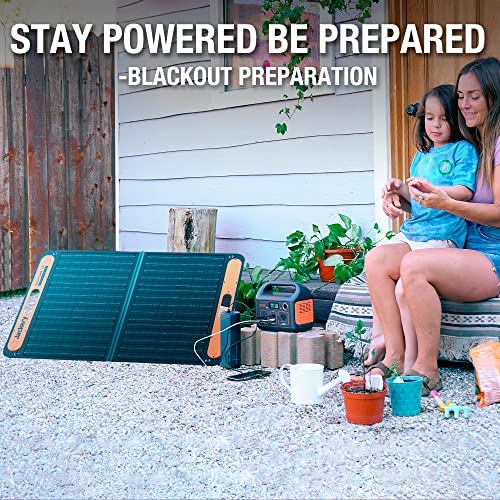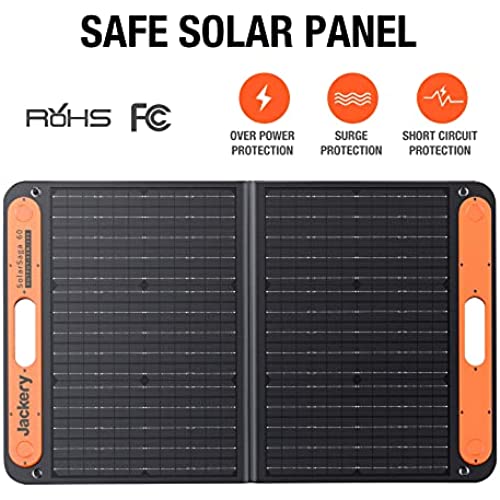









Jackery SolarSaga 60W Solar Panel for Explorer 160/240/500 as Portable Solar Generator, Portable Foldable Solar Charger for Summer Camping Van RV(Cant Charge Explorer 440/ PowerPro)
-

SpaceSkier
> 3 dayEasy to carry, easy to setup, works well to charge Jackery Battery.
-

loretta
> 3 daySuper easy to use and very fast charging of my jackery power station. I had been charging in the car or at home but this is so much better. I can leave at my off grid cabin and recharge whenever the battery gets low. Great addition to my jackery.
-

Dr. Jermey Hand Jr.
> 3 dayThe Solar Sega is the latest component added to our emergency preparedness schematic, which also includes the Jackery 160 and 240 Power Stations, as well as a host of power banks, etc. During short term power outages (which don’t necessitate cranking up the generator), the 160 and 240 each have a primary job addressing design flaws in our personal weather station, and our fixed wireless internet. I purchased the Solar Sega for use during longer term outages due to hurricanes, ice storms, etc. After the hurricanes and severe summer thunderstorms blow through and knock the power out, the weather is always clear and sunny. So the Solar Sega’s job will be to keep the Jackery Power Stations up and running, so that they in turn can keep the weather station and internet, as well as all of our devises and battery banks, up and running without having to string more extensions cords to the generator. This can be a real pain and a danger as well. Cords, splitters, more cords… . Now, thanks to Jackery, we are able to set up two “charging stations”-- one for wifi, husband’s computer, and his devises, and one for weather station monitor and all of my stuff. Before I provide the details of how my test run went, I’d like to address a comment a video reviewer had about the pouch on the back of the folded panel which holds the 9’ extension cord. The reviewer thinks this is a design flaw and I agree, to a degree. The issue is that when the 3-section panel is opened, and laid on the ground, the bulge in the middle (pouch on back of center panel) makes it impossible for the panel to lay flat. This is true. But it does not take into consideration that there are only three places on earth (and for each, only twice a year) where this matters-- where the panel would properly be flat-- 0° angle-- for optimal absorption of the sun’s energy. Here in the deep south, my angle of incidence for summer-- the smallest it will be all year-- is 6°. As you can see from the photograph, I did some improvisation with a piece of cardboard to get the correct tilt. At 6° the pouch is just barely was off the ground except at the middle. At all other, greater angles, it will be above the surface. So for folks who determine what angles of incidence are optimal at their latitudes, this isn’t that big a deal. If you just pitch the thing out the on the ground, it is. All that said, I would have liked to see the panel with a fourth section at one end, i.e., the pouch section. This would also allow the extension cord to be connected without the panel resting on it. How did it go? Good and bad. In the end it was fine, though I have some general questions for Jackery. The panel arrived just before noon on a day that started out with 25% scattered high clouds, and 102k LUX in full sun. I gathered up a white sheet upon which to lay the panel and deflect the heat, a piece of cardboard to get a tilt close to optimal, the Jackery 160 which was down to 63%, and had it set up and running by 12:15. Started off slowly but jumped up to 35W input in just a few seconds. (Maximum input to the station is 42W.) At 12:54 curiosity got the better of me and I’m glad it did. The Jackery 160 was in full critical mode! Lots of warning lights, and about 1/3 of the display was solid black. Hot as blazes-- this is not good-- unplugged it and took it inside. I just happened to have a lazar thermometer: the front was 110°; sides, about 100; back 90; top measured 122° and that’s after a couple of minutes inside. Took it out to the shop and put it in front of a window unit A/C. Within 10 minutes it had cooled to less than 80, and had been charged to 72%. But this was still not good. While I was at it, I measured the surface of the panel, 170°. Very not good. The maximum recharging temperature for the Jackery is 104°F. The “operating temperature range’ for the panel is 14-104°F. The air temperature was about 92 (didn’t think to get ground temperature). I risked it and put the Jackery back out there-- in the shade!-- at about 1:10pm. I monitored the temperatures. Jackery 160 surfaces stayed at 86-96, it was starting to cloud up and the temperature of the panel surface dropped to 150. Bottom line, the panel charged the Jackery 160 from 63% to full in 2 hours and 45 minutes which included about 15 minutes of panic and I’m guessing self-shut-down for some amount of time during the high temperature warning. To its credit, the station did what it was supposed to do-- shut down if over heating-- and recovered nicely. I’m assuming that maximum recharging temperature for the 160 is the temperature of the unit, since the air temp was not 104. So that’s on me; in the summer in Mississippi keep it in the shade (that 9’ extension cord will do the trick). But, question for Jackery (which has great customer service by the way). What does “operating temperature range” mean? It must mean the temperature of the panel itself. If so, what suggestions do you have for keeping the panel cooler? I’m thinking elevating it above ground to increase airflow is the place to start. If it’s going to do the job after summer storms/hurricanes that I described above, it has to work when it’s hot outside. Suggestions? Please note, this is not unique to the Solar Sega. All portable solar panels are black. That’s a heat absorption problem. A couple of other things. As I mentioned, the angle of incidence at your latitude matters for efficiency. I’d like to see Jackery include a map or table (season by latitude) in the owner’s manual with that information. I also tested how well the 160 did with pass-through wattage while charging with the panel. About as good as AC changing. Bottom bottom line is I’d like to see Jackery do three things: 1) explain to consumers the efficiency of its solar panel as it relates to angle of incidence; 2) highlight the recharging maximum temperatures with a waring to place the Power Stations in the shade; and 3) give some ideas about how one would efficiently recharge a Power Station via a Solar Sega in the heat of the summer.
-

mg
> 3 dayThis panel is great while camping. I used it for camping and it was great. You need patience because the sun charges as fast as it is clear. There are connectors for different items. I recommend a higher panel if you can afford it.
-

Chief
> 3 dayIm an avid astrophotographer. I wanted dependable solar panels to charge my Jackery Explorer 500 and 240 power stations during the day, then use that power to run my imaging rig all night while shooting planets and deep space images. I ended up buying both the Jackery SolarSaga 60 watt and 100 watt panels and I couldnt be happier with how they perform. The 60 watt is a great match for the Explorer 240. The 240s charge controller limits the input to about 40 watts so the 60 watt panel is perfect for it. Even with that limitation, it charges the 240 quickly. I use the 100 watt panel to charge the larger Explorer 500 power station and they work well together. I have used this 60 watt panel to charge the Explorer 500 but it takes a little longer. The 500 can charge at around 80 watts so it saves time using the larger panel for charging it. The 60 watt panel is easy to use because its very light and has a handy kickstand on the back to get it angled up at the sun. It has snaps to keep it folded when not in use. The material is very high quality and should stand up to heavy use for many years. I did buy a Rockpals 60 watt panel and while it works well, its output isnt quite as good as the Jackery Solarsaga 60 nor is it as easy to use (see photo). The Jackery produces more power with just the three panels vs the Rockpals four panels. The Jackery power stations charged by the panels allow me to do some nice planetary and deep sky work.
-

louann contreras
Greater than one weekI ordered this Along with the Jackery 300. Which full Sun it draws in 40 or so amps, plenty to keep it charging while using it to charge our phone and iPads. I would recommend it if your buying a Jackery power unit
-

D. Barnes
> 3 dayWhen the user manuals FAQ dodges a question about the products water resistance, keep it Sahara dry! Seriously, dont even forget and leave it outside overnight, because morning dew is enough to kill it. That said, the company replaced my failed unit within the warranty period. They did ask for video proof that the battery charged when plugged in to a wall outlet but not plugged in to the solar panel, which is fair. As soon as I sent them the video they shipped me a replacement unit, no further questions asked. I get good, solid charging power from it. Im at about 36-37 degrees North (VA-NC border), and on a sunny July midday with the haze of dew points in the 76-80F range it maxes out at about 48 watts. On a rare lower-humidity summer day it can get up to 52 watts. For most of the daylight hours in my partially-shaded back yard it outputs an average of about 40 watts for the whole day, and even after the sun ducks behind the trees in the evening its still giving 8 watts for about another hour. 5 stars for the panels performance and the companys customer service, but deduct a star because its 0% weather proof.
-

SteveO
> 3 dayI bought this with a Jackary 240 this winter and love the 240, but am not thrilled with the Solarsaga 60. When first used in best sun it made 46 watts charging. After that it usually only charges at 40 watts, even in great sun. I have tried angling it, but still cannot get more than 40 to 42 watts now. During its first use several of the solar cells discolored and became lightened. I sent an email to Jackary, but they have not responded. Many people on the Internet say that Jackary does not have the service after sale they once had. This should be sold as a 40 watt solar panel, not a 60 watt !
-

Placeholder
Greater than one weekGreat product ! Innovative ! Intelligent design ! Well made ! Excellent overall ! Highly recommended !













